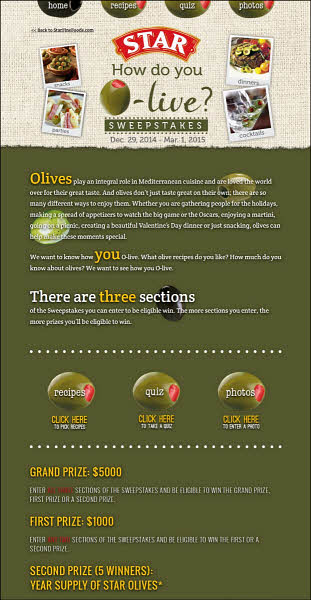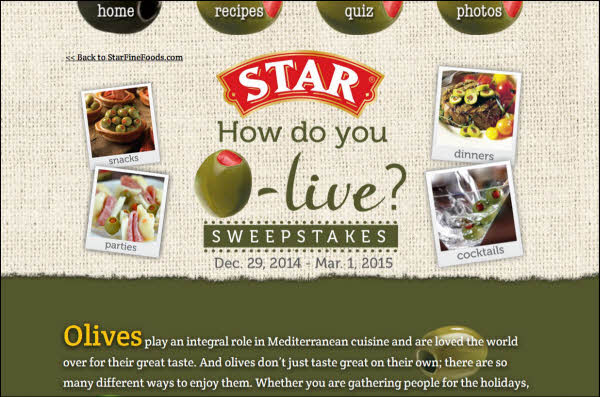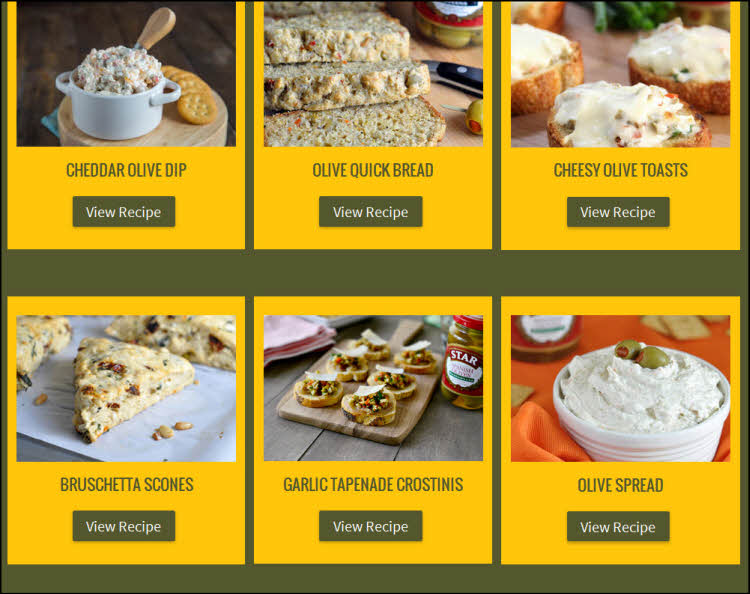by
Courtney Eckerle, Manager of Editorial Content
THE CUSTOMER
The Star Fine Foods brand, part of Borges USA, encompasses a majority of Mediterranean food products. The brand’s three main categories are olive oils, vinegars and olives, with olive oil and vinegar being its largest categories.
"Star also offers other specialty items, like sundried tomatoes, cherries; these make up a smaller part of our portfolio," Crystal Moritz, Product Marketing Manager, Star Fine Foods, said.
The Star Fine Foods brand is sold nationwide and was started in San Francisco in 1898. The strongest customer base is in the Western part of the United States, Moritz said, and most of the bigger campaigns are focused in those areas.
"I would say our customer base is pretty far reaching because of the many different types of products we offer, but generally speaking, our demographic skews toward women, middle to upper income," she said.
CHALLENGE
Moritz and her team had launched a three-month "Passport to the Mediterranean" campaign two years prior, which included weekly prizes of olive oil and a trip as the final prize. That campaign had a "Like" gate on Facebook, where contestants had to "Like" the Star Fine Foods Facebook page to enter.
"We had a lot of success as far as entries … it really increased our fan base," she said. After the success of that campaign, the team was looking for a way to engage those new fans.
However, the cost was "much higher … than what we did for this olive campaign," Moritz said. "When we were planning [this campaign], we knew what our budget was and we weren't going to be able to justify spending as much as we had on that other campaign," she said.
Her team wanted to do a campaign that would have a lower cost but would also serve as a way of educating consumers. Around the holidays, sales spike and then usually taper off in late January and February. Moritz said they wanted to lengthen that period.
The team also wanted to educate their customers on other ways to use olives, outside of the way they always had.
Prior to this educational campaign, the team had run a similar one to promote a new product — butter flavored olive oil.
"We wanted to help people understand how they could use this olive oil instead of butter — a healthier alternative, and we wanted to give them ways to use it," she said. "So we partnered with bloggers and we did recipe examples they could go check out to give them inspiration prior to them submitting their own recipe."
However, there were issues the team wanted to avoid with this new campaign. For the butter olive oil promotion, the main way people entered the contest was by creating a recipe using butter olive oil, taking a picture of it and uploading it. The other way to enter was through voting for those entries.
"But what we had found doing that campaign was that we didn't get a lot of people submitting recipes because the barrier to entry was high. We obviously got a lot more people voting," she said. "We should have had a longer time for people to vote because that was the easiest thing for people to do."
CAMPAIGN
When developing the plan for the olive campaign, the original idea was to launch an image-focused campaign, which featured people submitting pictures of themselves using olives. This idea is where the title "How Do You O-Live?" came from.
"But, having learned from the butter olive oil [campaign], the more work you make people do, the less likely they are to enter. We decided that just [requiring people to submit olive pictures] probably wasn't going to get the type of engagement we wanted," Moritz said.
Keeping the original campaign name, the team decided to create three different tiers for entering, some easier than others. This way, customers could enter the way that was best for them.
"You could take a quiz based off the information we have about olives for an entry. We have bloggers that created recipes, and you could just pick your favorites and get an entry, or you could submit a picture for an entry," she said.

Click here to see the full version of this creative sample
Entering more than one of these tiers unlocked
different levels of prizes participants would be eligible to win. This increase of prizes acted as the main motivation point for this campaign.
"So if you entered all three, you can win the grand prize of $5,000, whereas if you only entered one, you could only win a third prize," Moritz said.
Step #1. Provide inspiration
"We wanted people to at least have some inspiration, whether it was inspiration before they created a recipe or just inspiration of how they could use the product," Moritz said, adding that the team also wanted people to be able to pick their favorites from these recipes.
To create that inspiration, the team worked with bloggers to develop recipe content for the campaign. The content was posted to
the website for the campaign as well as to Star’s Facebook.

Click here to see the full version of this creative sample
Website traffic was largely generated from in-store collateral that contained a direct link to the entry site, but traffic was also generated from recipe bloggers. After a blogger would post an "O-live" recipe, they would link their post back to Star’s entry page so their followers could enter.
The team decided to host this contest on its own website in addition to its Facebook page because, "I wanted to be able to track in Google Analytics where our traffic was coming from. I can't do that as well in Facebook," Moritz said.
In the end, she said, the amount of people entering through the website and from Facebook was about even, although she added that having the website "attracted different people from different places."
Step #2. Connect in-store efforts to campaign
The in-store effort for this campaign included
neck hangers on products.

Click here to see the full version of this creative sample
"Also, in Safeway, Vons, SaveMart and Lucky, we had shelf blades up for about two months. They were about two foot tall blades. They talked about the 'How Do You O-live?' sweepstakes," Moritz said, adding that a lot of the imagery used for this included small Polaroids displaying different uses of olives — from cocktails, dinner entrees, snacks and appetizers for parties.
[Editor’s Note: Shelf blades are printed advertisements that hang vertically spanning multiple shelves.]
The imagery used across the campaign, from the website and social media to in-store materials was all consistent and focused on using the product.
Step #3. Engage customers with content

Click here to see the full version of this creative sample
The campaign’s website
featured blogger-developed recipes customers could view and print out. There was also a "Pin It" button featured in the top left of the image, allowing customers to easily post recipes to Pinterest. Additionally, Star created a "How Do You O-live" Pinterest board dedicated specifically to this contest.
Once a customer opens the recipe, there is a
banner at the bottom encouraging them to easily share the article to their social media networks.

Click here to see the full version of this creative sample
The quiz portion of entering engaged customers with olive tidbits. Once taking the quiz, customers would be entered into the lowest tier prize entry. By engaging in all three — photo uploads, quiz and voting — participants would be entered in for the grand prize of $5,000.

Click here to see the full version of this creative sample
After entering, customer photos would be displayed in a
photo album, which displayed how customers "O-lived" alongside their own caption.
For this campaign, the team utilized some of the lessons they learned about advertising strategies after Star’s butter oil contest. During this former contest, they found that cost-per-click was a lot higher when they invested in banner ads as opposed to Facebook ads. The team began more heavily investing in Facebook advertising, and they will eventually look into Pinterest promoted pins.
"I've been finding that we get a lot better cost-per-click for those things than some of the digital banners," Moritz said.
A different large driver of traffic was engaging people through external food blogs, which, according to Mortiz, "we saw as a valuable asset in promoting this promotion through food bloggers since they're reaching the type of people that we want to reach who are interested in recipes and food."
It’s important that every campaign take lessons from the one before it, she added. Her team has been "learning from each one, and we might invest in certain areas that we saw perform better," she said
RESULTS
"I was pleased we were able to find a solution where our investment was a lot less than before; we were still able to do a nice campaign with positive results without spending such a large portion of our budget," Moritz said, adding that the interaction level with customers was high enough to possibly make this a yearly campaign for Star Fine Foods.
The results from the "How Do You O-live" contest were:
- Unique entries: 14,638
- Total entries: 21,590
- Starfinefoods.com traffic up 288.26% from the same time last year, with 27.3% of traffic to the "How Do You O-live" microsite
"Now with new olive flavors coming out — such as lemon stuffed and hot pepper stuffed and some other recipe ones that have just hit the shelves — I think this will be a vehicle where we can talk about our new olive items in either the trivia, or we can have recipes that focus around those," Moritz said.
Creative Samples
- Contest tiers
- Contest microsite
- Neck hangers
- Blogger recipes
- Share banner
- Photo album
Sources
Star Fine FoodsShortStack — Contest vendor
Related Resources
MarketingSherpa Summit 2016 — At the Bellagio in Las Vegas, February 22-24
Inbound Marketing: Pinterest-based strategy leads to 77% new site trafficB2B Content Marketing: 60% lift in site traffic from embracing an inbound strategy















